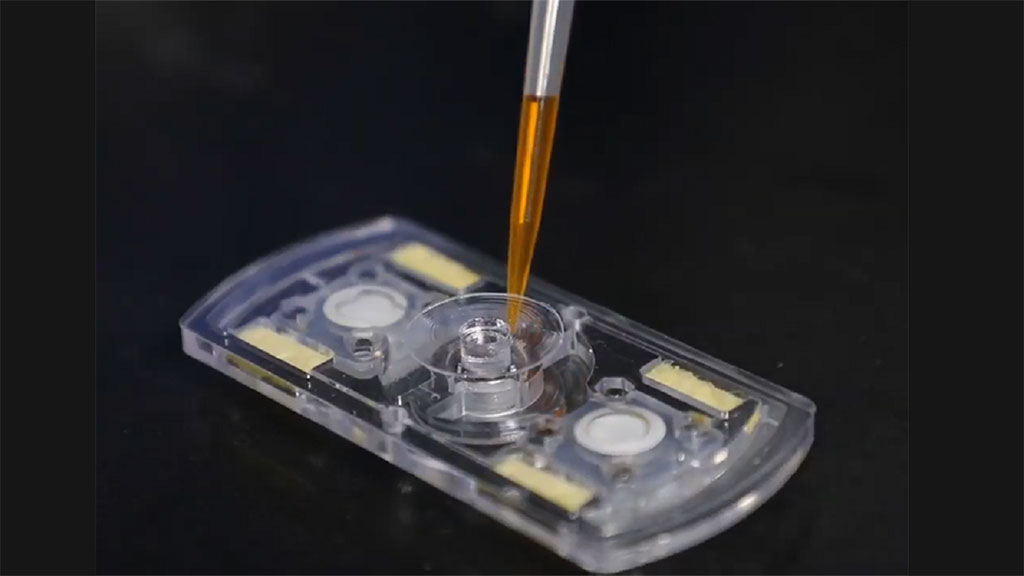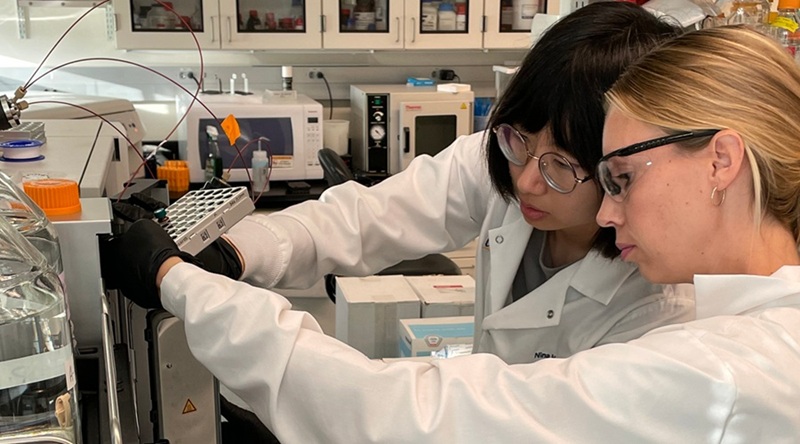Fidget Spinner Rapidly Detects Urinary Tract Infections
|
By LabMedica International staff writers Posted on 16 Jun 2020 |

Image: A fidget spinner for the point-of-care diagnosis of urinary tract infection (Photo courtesy of Ulsan National Institute of Science and Technology).
More than half of all women experience at least one episode of urinary tract infection (UTI) in their lifetime, with men also facing increasing risks of infection as they age. Current detection of UTIs relies on patients reporting symptoms followed by a laboratory culture of the urine for known bacterial culprits, which typically takes a few days.
Doctors tend to prescribe antibiotics to suppress any suspect cases of UTI before they get the test results, contributing to the increasing problem of antibiotic resistance. Dipstick tests that reduce the time taken for diagnoses come with a high chance for false positives. The point-of-care detection of pathogens in biological samples in resource-limited settings should be inexpensive, rapid, portable, simple and accurate.
A multidisciplinary and international team of scientists led by the Ulsan National Institute of Science and Technology (Ulsan, Republic of Korea) developed a fidget spinner-based device to detect UTIs from urine samples. The device was field tested on 39 patients in Tiruchirappalli, India who would have all been given antibiotics based on their symptoms alone. The team reported 59% of the patients were found to be over/under-treated with antibiotics, something that can be rectified using this novel device.
The custom-made fidget spinner rapidly concentrates pathogens in 1-mL samples of undiluted urine by more than 100-fold for the on-device colorimetric detection of bacterial load and pathogen identification. The test of the rectangular device with one or two nudges spins for a long time pushing any bacteria onto a membrane. This is then dyed, with a color change visible to the naked eye in less than one hour, which indicates the amount of bacterial load.
The device enabled the on-site detection of infection with the naked eye within 50 minutes in urine samples from the patients suspected of having a urinary tract infection. The team also showed that, in 30 clinical samples of urinary tract infection, the device can be used to perform an antimicrobial susceptibility test for the antimicrobial drugs ciprofloxacin and cefazolin within 120 minutes.
Another test gave a preliminary indication of the presence of antibiotic resistance. By testing the spun samples treated with different drugs and comparing them to untreated samples, the team was able to quickly make a decision on which antibiotic might work best to treat the UTI. While this does not compare to laboratory based tests for microbial resistance, it is still a useful add-on for resource poor settings that do not typically test for resistance.
The authors concluded that the test can be performed by novices and that there is no extensive training that is required to learn how to spin the device and read the results. The ease-of-use, low price point, availability of quick results, and immediate benefits such as reduction in prescription of antibiotics, makes the new spinner an attractive alternative for diagnosing UTIs. The study was published on May 18, 2020 in the journal Nature Biomedical Engineering.
Related Links:
Ulsan National Institute of Science and Technology
Doctors tend to prescribe antibiotics to suppress any suspect cases of UTI before they get the test results, contributing to the increasing problem of antibiotic resistance. Dipstick tests that reduce the time taken for diagnoses come with a high chance for false positives. The point-of-care detection of pathogens in biological samples in resource-limited settings should be inexpensive, rapid, portable, simple and accurate.
A multidisciplinary and international team of scientists led by the Ulsan National Institute of Science and Technology (Ulsan, Republic of Korea) developed a fidget spinner-based device to detect UTIs from urine samples. The device was field tested on 39 patients in Tiruchirappalli, India who would have all been given antibiotics based on their symptoms alone. The team reported 59% of the patients were found to be over/under-treated with antibiotics, something that can be rectified using this novel device.
The custom-made fidget spinner rapidly concentrates pathogens in 1-mL samples of undiluted urine by more than 100-fold for the on-device colorimetric detection of bacterial load and pathogen identification. The test of the rectangular device with one or two nudges spins for a long time pushing any bacteria onto a membrane. This is then dyed, with a color change visible to the naked eye in less than one hour, which indicates the amount of bacterial load.
The device enabled the on-site detection of infection with the naked eye within 50 minutes in urine samples from the patients suspected of having a urinary tract infection. The team also showed that, in 30 clinical samples of urinary tract infection, the device can be used to perform an antimicrobial susceptibility test for the antimicrobial drugs ciprofloxacin and cefazolin within 120 minutes.
Another test gave a preliminary indication of the presence of antibiotic resistance. By testing the spun samples treated with different drugs and comparing them to untreated samples, the team was able to quickly make a decision on which antibiotic might work best to treat the UTI. While this does not compare to laboratory based tests for microbial resistance, it is still a useful add-on for resource poor settings that do not typically test for resistance.
The authors concluded that the test can be performed by novices and that there is no extensive training that is required to learn how to spin the device and read the results. The ease-of-use, low price point, availability of quick results, and immediate benefits such as reduction in prescription of antibiotics, makes the new spinner an attractive alternative for diagnosing UTIs. The study was published on May 18, 2020 in the journal Nature Biomedical Engineering.
Related Links:
Ulsan National Institute of Science and Technology
Latest Microbiology News
- Blood-Based Diagnostic Method Could Identify Pediatric LRTIs
- Rapid Diagnostic Test Matches Gold Standard for Sepsis Detection
- Rapid POC Tuberculosis Test Provides Results Within 15 Minutes
- Rapid Assay Identifies Bloodstream Infection Pathogens Directly from Patient Samples
- Blood-Based Molecular Signatures to Enable Rapid EPTB Diagnosis
- 15-Minute Blood Test Diagnoses Life-Threatening Infections in Children
- High-Throughput Enteric Panels Detect Multiple GI Bacterial Infections from Single Stool Swab Sample
- Fast Noninvasive Bedside Test Uses Sugar Fingerprint to Detect Fungal Infections
- Rapid Sepsis Diagnostic Device to Enable Personalized Critical Care for ICU Patients
- Microfluidic Platform Assesses Neutrophil Function in Sepsis Patients
- New Diagnostic Method Confirms Sepsis Infections Earlier
- New Markers Could Predict Risk of Severe Chlamydia Infection
- Portable Spectroscopy Rapidly and Noninvasively Detects Bacterial Species in Vaginal Fluid
- CRISPR-Based Saliva Test Detects Tuberculosis Directly from Sputum
- Urine-Based Assay Diagnoses Common Lung Infection in Immunocompromised People
- Saliva Test Detects Implant-Related Microbial Risks
Channels
Clinical Chemistry
view channel
Online Tool Detects Drug Exposure Directly from Patient Samples
Doctors often rely on patient interviews and medical records to determine what medications a person has taken, but this information is frequently incomplete. People may forget drugs they used, take over-the-counter... Read more
Chemical Imaging Probe Could Track and Treat Prostate Cancer
Prostate cancer remains a leading cause of illness and death among men, with many patients eventually developing resistance to standard hormone-blocking therapies. These drugs often lose effectiveness... Read moreMolecular Diagnostics
view channel
Ultrasensitive Method Detects Low-Frequency Cancer Mutations
Liquid biopsy has emerged as a promising approach for cancer detection and treatment monitoring, although its clinical impact has been limited by the extremely low levels of tumor-derived DNA circulating in blood.... Read more
Blood Test Enables Non-Invasive Endometriosis Detection
Endometriosis is a chronic, complex, yet relatively common gynecological disorder, reportedly affecting 1 in 10 adult and adolescent women. Endometriosis causes tissue similar to the lining of the uterus... Read moreHematology
view channel
MRD Tests Could Predict Survival in Leukemia Patients
Acute myeloid leukemia is an aggressive blood cancer that disrupts normal blood cell production and often relapses even after intensive treatment. Clinicians currently lack early, reliable markers to predict... Read more
Platelet Activity Blood Test in Middle Age Could Identify Early Alzheimer’s Risk
Early detection of Alzheimer’s disease remains one of the biggest unmet needs in neurology, particularly because the biological changes underlying the disorder begin decades before memory symptoms appear.... Read more
Microvesicles Measurement Could Detect Vascular Injury in Sickle Cell Disease Patients
Assessing disease severity in sickle cell disease (SCD) remains challenging, especially when trying to predict hemolysis, vascular injury, and risk of complications such as vaso-occlusive crises.... Read more
ADLM’s New Coagulation Testing Guidance to Improve Care for Patients on Blood Thinners
Direct oral anticoagulants (DOACs) are one of the most common types of blood thinners. Patients take them to prevent a host of complications that could arise from blood clotting, including stroke, deep... Read moreImmunology
view channel
Routine Blood Test Can Predict Who Benefits Most from CAR T-Cell Therapy
CAR T-cell therapy has transformed treatment for patients with relapsed or treatment-resistant non-Hodgkin lymphoma, but many patients eventually relapse despite an initial response. Clinicians currently... Read more
New Test Distinguishes Vaccine-Induced False Positives from Active HIV Infection
Since HIV was identified in 1983, more than 91 million people have contracted the virus, and over 44 million have died from related causes. Today, nearly 40 million individuals worldwide live with HIV-1,... Read more
Gene Signature Test Predicts Response to Key Breast Cancer Treatment
DK4/6 inhibitors paired with hormone therapy have become a cornerstone treatment for advanced HR+/HER2– breast cancer, slowing tumor growth by blocking key proteins that drive cell division.... Read more
Chip Captures Cancer Cells from Blood to Help Select Right Breast Cancer Treatment
Ductal carcinoma in situ (DCIS) accounts for about a quarter of all breast cancer cases and generally carries a good prognosis. This non-invasive form of the disease may or may not become life-threatening.... Read morePathology
view channel
Rapid Low-Cost Tests Can Prevent Child Deaths from Contaminated Medicinal Syrups
Medicinal syrups contaminated with toxic chemicals have caused the deaths of hundreds of children worldwide, exposing a critical gap in how these products are tested before reaching patients.... Read more
Tumor Signals in Saliva and Blood Enable Non-Invasive Monitoring of Head and Neck Cancer
Head and neck cancers are among the most aggressive malignancies worldwide, with nearly 900,000 new cases diagnosed each year. Monitoring these cancers for recurrence or relapse typically relies on tissue... Read more
Common Health Issues Can Influence New Blood Tests for Alzheimer’s Disease
Blood-based tests for Alzheimer’s disease are transforming diagnosis by offering a simpler alternative to spinal taps and brain imaging. However, many people evaluated at memory clinics also live with... Read more
Blood Test Formula Identifies Chronic Liver Disease Patients with Higher Cancer Risk
Chronic liver disease affects millions worldwide and can progress silently to hepatocellular carcinoma (HCC), one of the deadliest cancers globally. While surveillance guidelines exist for patients with... Read moreTechnology
view channel
Artificial Intelligence Model Could Accelerate Rare Disease Diagnosis
Identifying which genetic variants actually cause disease remains one of the biggest challenges in genomic medicine. Each person carries tens of thousands of DNA changes, yet only a few meaningfully alter... Read more
AI Saliva Sensor Enables Early Detection of Head and Neck Cancer
Early detection of head and neck cancer remains difficult because the disease produces few or no symptoms in its earliest stages, and lesions often lie deep within the head or neck, where biopsy or endoscopy... Read moreIndustry
view channel
Abbott Acquires Cancer-Screening Company Exact Sciences
Abbott (Abbott Park, IL, USA) has entered into a definitive agreement to acquire Exact Sciences (Madison, WI, USA), enabling it to enter and lead in fast-growing cancer diagnostics segments.... Read more



















